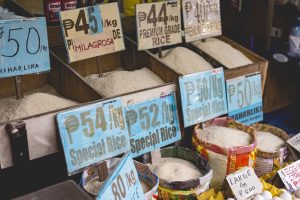The Philippines yesterday declared a food security emergency in order to bring down the price of rice, which officials said have remained high despite last year’s cuts to the tariffs on imported rice.
In a statement, Agriculture Secretary Francisco Tiu-Laurel said that the move was prompted by the “extraordinary” rise in local rice prices, and came on the recommendation of the National Price Coordinating Council (NPCC).
“This emergency declaration allows us to release rice buffer stocks held by the National Food Authority to stabilize prices and ensure that rice, a staple food for millions of Filipinos, remains accessible to consumers,” he said in the statement.
The Department of Agriculture said that it plans to release 300,000 metric tons of rice currently being stockpiled by the National Food Authority (NFA) at a rate of 30,000 metric tons per month.
These rice stocks will be sold to government agencies, local governments, and outlets under the government’s Kadiwa ng Pangulo, or “rice for all,” program to “stabilize rice prices and protect consumers from further price hikes,” the DA said. The release of rice stocks will also allow the NFA to empty its warehouses in time for the harvest season.
Prices of the staple grain have been on the rise in the Philippines since July 2023, posing political challenges for President Ferdinand Marcos Jr.’s administration. According to the DA’s statement, the prices of regular milled rice and well-milled rice in December 2024 were about 19-20 percent higher than before the increase in July 2023.
These price increases came despite Marcos issuing an executive order in June of last year, cutting the tariff on imported rice from 35 percent to 15 percent. In announcing the order, Marcos said that the updated tariff schedule “aims to augment supply, manage prices and temper the inflationary pressures of various commodities, consistent with the Philippine national interest and the objective of safeguarding the purchasing power of Filipinos.”
The implementation of the reduced tariff and the government’s other efforts to make rice more accessible, including the Kadiwa ng Pangulo, have helped tame retail prices to some extent last year. But as the U.S. Department of Agriculture’s Foreign Agricultural Service (FAS) noted in September, retail prices “remain generally elevated compared to the same period last year despite tariff cuts.”
As well as declaring the food security emergency, the Philippine Star also reported that the DA plans to gradually lower the price cap on imported rice in Metro Manila markets, which is currently set at P58 ($0.99) per kilogram. Starting February 5, imported rice will be capped at P55 ($0.94) per kilogram. The DA aims to reduce the price by P49 ($0.84) in March.
The Philippines is the largest purchaser of rice in the world, importing around 4 million metric tons of the staple per year to make up the shortfall in local production. The majority comes from Vietnam, which early last year agreed to supply the Philippines with an additional 1.5 -2 million metric tons of white rice at a “competitive and affordable price” for each of the next five years.
According to the FAS, the country is projected to produce 12.69 million tons of milled rice in 2024-25, while consuming a projected 17.3 million tons.

































